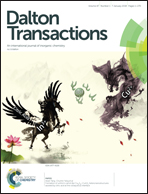Controlling the emission in flexibly-linked (N^C^N)platinum dyads†
Abstract
The synthesis, spectroscopic and theoretical characterizations of dinuclear Pt(II) complexes where the two chromophoric units are connected though a polyether chain via either the central benzene ring of the tridentate ligand dpyb (Pt-2), or the phenylacetylide ligand (Pt-3), are described. The spacer, which contains four oxyethylene –CH2CH2O– units, is flexible and long enough to allow a self-association of the Pt units by folding, as shown by DFT calculations. Comparison of the photophysical properties of the dinuclear complex Pt-2 with those of the mononuclear complex Pt-1, used as reference, demonstrates the key role played by the linker group in the interaction processes. In addition, the emission of complex Pt-2 was found to be affected by the temperature, nature of the solvent, and cation coordination as evidenced by luminescence and 1H NMR studies. The interacting processes are highly dependent on the solvent polarity that controls the – extended vs folded – arrangement and, consequently, induces solvatochromic shifts. This unique photophysical behavior of Pt-2 allows the modulation of the emission from green to deep-red (up to 125 nm) over the visible part of the spectrum. By contrast, complex Pt-3 has a high propensity to form a red-shifted intense emissive excimer. DFT and TD-DFT investigations of the excimers in Pt-2 and Pt-3 consistently show a much stronger interaction in the latter complex.



 Please wait while we load your content...
Please wait while we load your content...